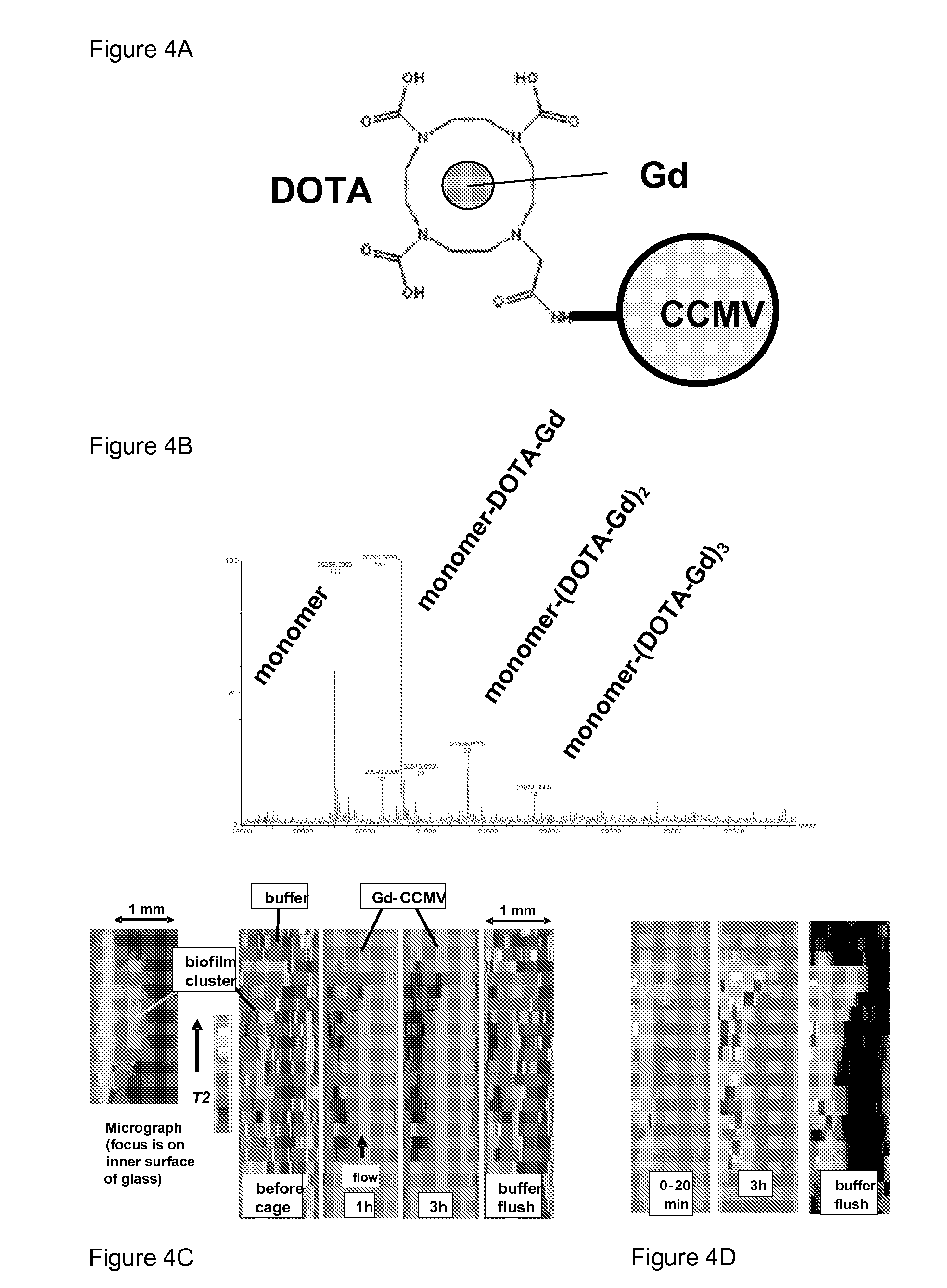Novel nanoparticles for biofilm targeting
a biofilm and nanoparticle technology, applied in the field of new nanoparticles for biofilm targeting, can solve the problems of inability to treat conventionally, significant threat to human health, and ineffective conventional antimicrobials against biofilm based infections
- Summary
- Abstract
- Description
- Claims
- Application Information
AI Technical Summary
Benefits of technology
Problems solved by technology
Method used
Image
Examples
example 1
CCMV as an Engineered Multifunctional Nanoparticle
[0045]CCMV has become a model system for studies of viral structure and self-assembly [Speir 1995, Zlotnick 2001] (FIG. 2). We have developed means to engineer CCMV both genetically and chemically [Douglas 1998; Gillitzer 2002; Basu 2003; Klem 2003]. We have constructed a library that contains constructs of CCMV that contain single amino acid changes at 32 of its 190 residues, all of which assemble into intact particles. We have developed a variety of protein cages, including CCMV, for targeted drug delivery to tumor cells [Flenniken 2005]. Using site directed mutagenesis cysteines (C) were placed on CCMV in positions that optimize accessibility to functionalization of sulfhydryls via maleimide moieties, while obviating the need for storage in reducing agent to prevent cross-linking of cages via thiol groups. Our ATR-FTIR data show that the biotins present on the surface of CCMV-S-B constructed from S102C are accessible to streptavid...
example 2
Immune Response
[0047]Based on antibody titer, we showed that the response to CCMV, genetically modified by incorporation of cysteine residues, is slightly more mild than the response to keyhole limpet hemocyanine (KLH), a protein used for vaccine development in humans [Krug 2004] (FIG. 3). These data suggest that the surface of CCMV may not need to be modified to shield it from the host immune response in mammalian systems. The immune response can be further mitigated by surface modification if required [e.g., Raja 2003]. In these experiments the mice exhibited no signs of an extreme immune response such as anaphylactic shock (for which a murine model exists) [Moon 2005]. In contrast, mice injected with M13 bacteriophage exhibited an extreme immune response (two out of three died within 2 weeks).
example 3
MRM of Gd-CCMV Penetration into a Biofilm
[0048]We prepared Gd-DOTA-CCMV in which Gd is coupled via the clinically relevant chelating agent p-NHS-Bn-DOTA (DOTA) (Macrocylics) (FIG. 4a). DOTA was covalently linked to lysine residues (confirmed by LC / MS) (FIG. 4b). MRM was used to image a S. epidermidis biofilm (FIG. 4c).
[0049]A schematic of Gd coupling to CCMV via DOTA is shown in FIG. 4a. FIG. 4b shows LC / MS data verifying the coupling. FIG. 4c shows MRM results showing penetration of Gd-DOTA-CCMV into a S. epidermidis biofilm. Biofilm was cultured in TSB in a 1 mm square glass capillary tube and imaged as for a previous study [Seymour 2004]. Biofilm was visible by eye, and the dense nature of the biofilm was evident by transmission microscopy at 100× (left image). MRM images taken before exposure to Gd-DOTA-CCMV and at various times after exposure are on the right, color coded to indicate the T2 values (voxel size 20×156 pm, 300 μm depth). Water has a large T2 value (red) that is di...
PUM
| Property | Measurement | Unit |
|---|---|---|
| temperature | aaaaa | aaaaa |
| temperature | aaaaa | aaaaa |
| diameter | aaaaa | aaaaa |
Abstract
Description
Claims
Application Information
 Login to View More
Login to View More - R&D
- Intellectual Property
- Life Sciences
- Materials
- Tech Scout
- Unparalleled Data Quality
- Higher Quality Content
- 60% Fewer Hallucinations
Browse by: Latest US Patents, China's latest patents, Technical Efficacy Thesaurus, Application Domain, Technology Topic, Popular Technical Reports.
© 2025 PatSnap. All rights reserved.Legal|Privacy policy|Modern Slavery Act Transparency Statement|Sitemap|About US| Contact US: help@patsnap.com



